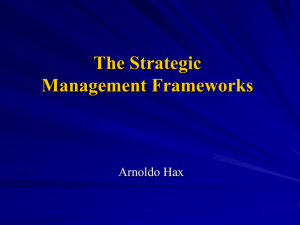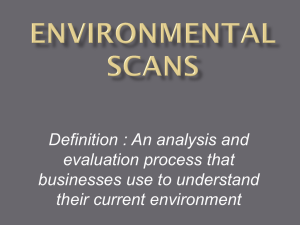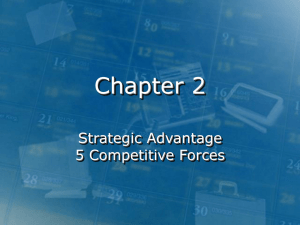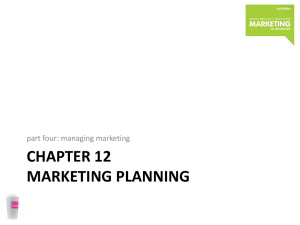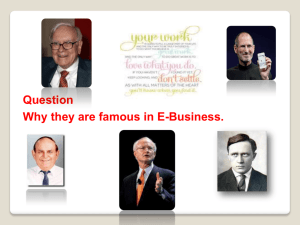The Strategic Management Frameworks Arnoldo Hax Alfred P. Sloan Professor of Management
advertisement
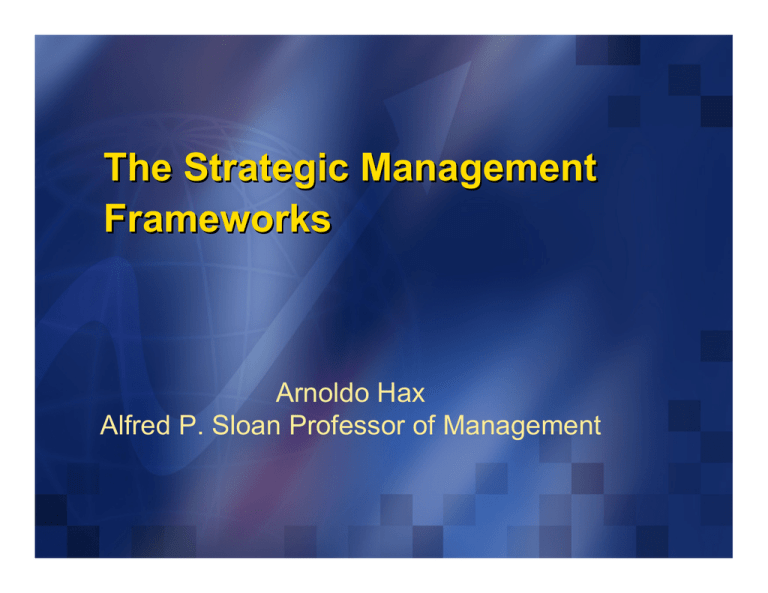
The Strategic Management Frameworks Arnoldo Hax Alfred P. Sloan Professor of Management The Frameworks for Competitive Positioning • • Porter Resource-Based View of the Firm • The Delta Model Porter’s Framework for Explaining the Profitability of a Business Competitive Positioning Industry Structure Achieving sustainable competitive advantage Factors affecting industry profitability Strategy Formulation and Implementation Defining and executing the managerial tasks Elements of Industry Structure: Porter’s Five-Forces Government Action - Industry protection - Industry regulation - Consistency of policies - Capital movements among countries - Custom duties - Foreign exchange - Foreign ownership - Assistance provided to competitors Rivalry Among Competitors - Concentration & balance among competitors - Industry growth - Fixed (or storage) cost - Product differentiation - Intermittent capacity increasing - Switching costs - Corporate strategic stakes New Entrants Threat of new entrants Barriers to Entry - Economies of scale - Product differentiation - Brand identification - Switching cost - Access to distribution channels - Capital requirements - Access to latest technology - Experience & learning effects Barriers to Exit - Asset specialization - One-time cost of exit - Strategic interrelationships with other businesses - Emotional barriers - Government & social restrictions Industry Competitors Intensity of Rivalry Suppliers Buyers Power of Suppliers - Number of important suppliers - Availability of substitutes for the supplier's products - Differentiation or switching cost of supplier's products - Supplier's threat of forward integration - Industry threat of backward integration - Supplier's contribution to quality or service of the industry products - Total industry cost contributed by suppliers - Importance of the industry to supplier's profit Bargaining Power of Buyers Threat of substitutes Bargaining Power of Suppliers Substitutes Availability of Substitutes - Availability of close substitutes - User's switching costs - Substitute producer's profitability & aggressiveness - Substitute price-value Figure by MIT OCW. Power of Buyers - Number of important buyers - Availability of substitutes for the industry products - Buyer's switching costs - Buyer's threat of backward integration - Industry threat of forward integration - Contribution to quality or service of buyer's products - Total buyer's cost contributed by the industry - Buyer's profitability Porter’s Five-Forces Model Applied to the Pharmaceutical Industry in the Early 1990s Barriers to Entry (Very Attractive) - Steep R&D experience curve effects - Large economies-of-scale barriers in R&D and sales force - Critical mass in R&D and marketing require global scale - Significant R&D and marketing costs - High risk inherent in the drug development process - Increasing threat of new entrants coming from biotechnology companies Bargaining Power of Suppliers (Very Attractive) - Mostly commodities - Individual scientists may have some personal leverage Bargaining Power of Buyers (Mildly Unattractive) - The traditional purchasing process was highly price insensitive: the consumer (the patient) did not buy, and the buyer (the physician) did not pay - Large power of buyers, particularly plan sponsors and cost containment organizations, are influencing the decisions to prescribe less expensive drugs - Mail-order pharmacies are obtaining large discounts on volume drugs - Large aggregated buyers (e.g., hospital suppliers, large distributors, government institutions) are progressively replacing the role of individual customers - Important influence of the government in the regulation of the buying process Intensity of Rivalry & Competition Threat of Substitutes (Mildly Unattractive) - Generic and "Me-too" drugs are weakening branded, proprietary drugs - More than half of the life of the drug patent is spent in the product development and approval process - Technological development is making imitation easier - Consumer aversion to chemical substances erodes the appeal for pharmaceutical drugs Intensity of Rivalry (Attractive) - Global competition concentrated among fifteen large companies - Most companies focus on certain types of disease therapy - Competition among incumbents limited by patent protection - Competition based on price and product differentiation - Government intervention and growth of "Me-too" drugs increase rivalry - Strategic alliances establish collaborative agreements among industry players - Very profitable industry, however with declining margins Figure by MIT OCW. SUMMARY ASSESSMENT OF THE INDUSTRY ATTRACTIVENESS (Attractive) Make a business in an attractive industry where you can excel; then excel by achieving a low cost of differentiation though unique activities Firm Infrastructure SUPPORT ACTIVITIES Human Resource Management Technology Development Procurement MARGIN Inbound logistics Operations Outbound Marketing logistics & sales PRIMARY ACTIVITIES THE VALUE CHAIN Figure by MIT OCW. Service Management Infrastructure Very strong corporate culture One of America's best managed companies Superb financial management & managerial control capabilities Very lean structure Highly concerned about ethics, ecology, and safety Human Resources Management Friendly & cooperative labor relations Strong recruiting programs in top universities Excellent training & development Excellent rewards & health-care programs Technology Development Technology leader; developer of break-path drugs (e.g., Vasotec, Sinement, Mevacor) Intensive R&D spending Strengthening technological & marketing capabilities through strategic alliances (Astra, DuPont, and Johnson & Johnson) Fastest time-to-market in drug discovery and drug approval processes Procurement MARGIN Vertical integration in chemical products Inbound Logistics Manufacturing Outbound Logistics Marketing & Sales Service Increasing manufacturing flexibility and cost reductions Acquisition of Medco provides unique distribution capabilities and information technology support Marketing leadership Medco's service excellence has attracted major corporations and health-care organizations as clients. Stressing quality and productivity improvements Global facilities network Large direct sales staff Global marketing coverage Medco is the number one mail-order firm Leverage through Medco, including powerful marketing groups and sales forces, and proprietary formulary Medco IT infrastructure and database, covering patients, physicians, and drug uses Strategic alliances MERCK'S VALUE CHAIN Figure by MIT OCW. There are two ways to compete: Low Cost or Differentiation The efficiency of the low cost provider’ provider’s cost structure allows pricing below the average competitor, which in the long run may put average competitors out of business. business. This is why the alternative to low cost needs to be differentiation, differentiation, offering unique product attributes that the customer values and will pay a premium for. Best Product Margin $/Unit Margin Margin Cost Cost Cost Average Player Low Cost Player Differentiation Player Total Customer Solutions Player However, the Total Customer Solutions positioning offers a possible preferred alternative by introducing significant cost savings (and/or revenue increases) to the customer. Best Product Total Customer Solutions Margin Margin $/Unit Margin Margin Cost Cost Cost Average Player Low Cost Player Differentiation Player Cost Critical Elements in Porter’s Frameworks Focus of Strategic Attention Porter Industry/ Business Types of Competitive Advantage Low cost or Differentiation Basic Unit of Competitive Advantage Activities Porter’s winning Formula Pick a business in an attractive industry in which you can excel. Notice that Porter’s Framework stressed rivalry and competition. Therefore,an attractive industry is one in which we can achieve as close to a monopolistic position as possible. In turn, the message of the value chain is to achieve sustainable advantage by beating your competitors, if not in all, at least in those activities that are most crucial to competition. Strategy is War! The Resource-Based View of the Firm Framework Resources can be classified into three broad categories • Tangible assets are the easiest to value, and often are the only resources that appear on a firm’s balance sheet. They include real estate, production facilities, and raw materials, among others. Although tangible resources may be essential to a firm’s strategy, due to their standard nature, they rarely are a source of competitive advantage. There are, of course, notable exceptions. Resources can be classified into three broad categories (Cont’d) • Intangible assets include such things as company reputations,brand names, cultures, technological knowledge, patents and trademarks, and accumulated learning and experience. These assets often lay an important role in competitive advantage (or disadvantage), and firm value. Resources can be classified into three broad categories (Cont’d) • Organizational capabilities are not factor inputs like tangible and intangible assets; they are complex combinations of assets, people, and processes that organizations use to transform inputs into outputs. The list of organizational capabilities includes a set of abilities describing efficiency and effectiveness: low cost structure, “lean” manufacturing, high quality production, fast product development. Source: David Collis and Cynthia Montgomery 4. Select a strategy which best exploits the firm's resources and capabilities relative to external opportunities. Strategy 3. Appraise the rent-generating potential of resources and capabilities in terms of: i) their potential for sustainable competitive advantage, and ii) the appropriability of their returns. Competitive Advantage 2. Identity the firm's capabilities: What can the firm do more effectively than its rivals? Identify the resources inputs to each capability, and the complexity of each capability. Capabilities 1. Identify and classify the firm's resources. Appraise strengths and weaknesses relative to competitors. Identify opportunities for better utilization of resources. 5. Identify resource gaps which need to be filled. Invest in replenishing, augmenting and upgrading the firm's resource base. Resources A RESOURCE-BASED APPROACH TO STRATEGY ANALYSIS: A PRACTICAL FRAMEWORK Figure by MIT OCW. SUSTAINABILITY UNIQUE COMPETENCIES Supported by resources and capabilities owned by the firm Lack of substitution and imitation by competitors Generating Value Sustaining Value COMPETITIVE ADVANTAGE Retaining Value Value not Offset by Costs APPROPRIABILITY OPPORTUNISM/TIMING Retention of value created inside the firm Offsetting the cost of acquiring resources and capabilities THE RESOURCE-BASED VIEW-ELEMENTS OF COMPETITIVE ADVANTAGE Figure by MIT OCW. The Resource-Based View of the Firm Wining Formula Develop resources and capabilities which are rare, valuable, non-tradeable, that form the basis of the core competencies of the firm; make those resulting advantages sustainable by precluding imitation or substitution from competitors; appropriate the resulting economic rent by preventing negative hold-up and slack conditions; and make sure that the implementation process is done in such a way that its associated costs do not upset the resulting benefits. It is Strategy by Real Estate! Comparison of Critical Elements in Porter’s and Resource-Based View Frameworks Focus of Strategic Attention Types of Competitive Advantage Basic Unit of Competitive Advantage Porter ResourceBased View Industry/Business Corporation Low cost or Differentiation Activities Resources, Capabilities, Core Competencies Core Products, Strategic Architecture Comparison Among Strategy Frameworks Porter Focus of Strategic Attention Industry/ Business Types of Compe- Low cost or titive Advantage Differentiation Basic Unit of Competitive Advantage Strategy As Activities Resource-Based View Delta Model Extended Enterprise Corporation (The Firm, The Customer, The Suppliers , The Complementors) Resources, Capabilities, Core Best Product, Total Competencies Customer Solutions, System Lock-In Core Products, Strategic Architecture Adaptive Processes: Operational Effectiveness, Customer Targeting, Innovation Real Estate Rivalry Bonding The Delta Model - An integrative strategic framework System Lock In Total Customer Solution Best Product Customer Segmentation and Customer Value Proposition Bundle of Competencies Mission of the Business • Business Scope • Core Competencies Competitive Positioning Industry Structure • External factors determining industry attractiveness • Activities that drive profitability Innovation Business The Strategic Agenda Customer Targeting Adaptive Processes Strategic Agenda Aggregate and Granular Metrics Experimentation and Feedback Operational Effectiveness The Adaptive Processes: Linking Strategy with Execution Business Model Innovation Operational Effectiveness Customer Targeting • The process of new product development • Should ensure a continuous stream of new products and services to maintain the future viability of the business • The management of the customer interface • Identification and selection of attractive customers and enhancement of customers’ customers’ performance • Should establish best revenue i f t t f h t t • The production and delivery of products and services to the customer • Should produce the most effective cost and asset infrastructure to support the chosen strategic position of the business • Operational Effectiveness: This process is responsible for the delivery of products and services to the customer. In a traditional sense, this includes all the elements of the internal supply chain. Its primary focus is on producing the most effective cost and asset infrastructure to support the desired strategic position of the business. In a more comprehensive sense, operational effectiveness should expand its external scope to include suppliers, customer, and key complementors, thus establishing an extended supply chain. This process is the heart of a company’s productive engine as well as its source of capacity and efficiency. • Customer Targeting: This process addresses the business-to-customer interface. It encompasses the activities intended to attract, satisfy, and retain customers, and ensures that customer relationships are managed effectively. Its primary objectives are to identify and select attractive customers and to enhance their performance, either by helping to reduce their costs or increase their revenues. The ultimate goal of this process is to establish the best revenue infrastructure for the business. • Innovation: This process ensures a continuous stream of new products and services to maintain the future viability of the business. It mobilizes all the creative resources of the firm- including its technical, production, and marketing capabilities- to develop an innovative infrastructure for the business. It should not limit itself to the pursuit of internal product development, but should extend the sources of Innovation to include suppliers, customers, and key complementors. The heart of this process is the renewal of the business in order to sustain its competitive advantage and its superior financial performance. The Role of Adaptive Processes In supporting the Strategic Positioning of the Business Strategic Positioning Best Product Total Customer Solutions System Lock-In •Best Product Cost •Best Customer Benefits •Best System Performance • Identify product cost drivers • Improve stand alone product cost • Improve customer economics • drivers • Improve horizontal linkages in the • components of total solutions • Improve system performance • drivers • Integrate complementors in • improving system performance •Target Distribution Channels •Target Customer Bundles •Target System Architecture • Maximize coverage through • multiple channels • Obtain low cost distribution • Identify and enhance the • profitability of each product by • channel • Identify and exploit opportunities to • add value to key customers by • bundling solutions and customization • Increase customer value and possible • alliances to bundle solutions • Select key vertical markets • Examine Channel ownership options • Identify leading complementors • in the system • Consolidate a lock-in position • with complementors • Expand number and variety of • complementors •Product Innovation •Customer Service Innovation •System Innovation • Develop family of products • based on common platform • First to market, or follow rapidly• stream of products • Identify and exploit joint development • linked to the customer value chain • Expand your offer into the customer value • chain to improve customer economics • Integrate and innovate customer care • functions • Increase customer lock-in through • customization and learning • Create customer and system lock• in, and competitive lock-out • Design propriety standard within • open architecture - Complex interfaces - Rapid evolution - Backward compatibility Examples of The Role of Adaptive Processes in Supporting the Strategic Options of the Triangle •STRATEGIC POSITIONING Customer Operational Targeting Effectiveness Innovation ADAPTIVE PROCESSES •Best Product •Total Customer Solutions •System Lock-In •Superlative Low Cost •Infrastructure •Integrating the Customer •Infrastructure •Uniqueness of Facilities with Dominant 1st Mover •Southwest Airlines •Nucor •EDS •Castrol •Nucor client •Rural Wal-Mart •Effective Arm-Length Treatment of Customer •Closest Customer Interaction •Owning the Seller & Buyer Interface •Dell-Relationship Customer •Dell-Transactional Customer •Ebay •Yellow Pages •Endless Chain of Internal Innovation •Superior Joint Innovation with Customer •Early Digital Equipment Corp. •3M •National Starch •Owning the Complementors •Microsoft-Intel The Elements of the Delta Model The Triangle - The source of the strategic options Business Mission - Product scope - Market scope (customer, consumer, channel) - Complementor scope - Geographical scope - Core competencies The Three Strategic Options Best Product Total Customer Solution Driver Driver Driver (Either Local-Regional-Global) Align with Strategic Option Industry Structure - Relevant industry focus Business Industry Competitive Positioning - Relevant value chain - Focus Internal value chain: - Business Business Strategic Agenda Adaptive Process Priorities - OE - CT -I System Lock-In + Customer Industry Integrated value chain: - Business & customer + Complementor Industry Systems value chain - Business complementor and customer Align with strategic option 1st 3rd 2nd 2nd 1st 3rd Aggregate/Granular Metrics Align with strategic option Experimentation & Feedback Align with strategic option 3rd 2nd 1st TH E D ELTA MODE L AND T HE T HR E E S T R AT E G I C O P T I O N S Figure by MIT OCW. Porter’s Five Forces Model NEW ENTRANT Threat of New Entrants INDUSTRY COMPETITORS Bargaining Power of Suppliers SUPPLIERS Intensity of Rivalry Bargaining Power of Buyers Threat of Substitutes SUBSTITUTES P ORT E R' S F I VE F ORCE S MODE L Figure by MIT OCW. BUYERS New Entrants (Entry Barriers) F E B Complementors Industry C Competitors Suppliers Intensity of Rivalry Buyers D A Substitutes A) Create a powerful 10x force to change the rules of the game. Reject imitation of competitors, a product-centric mentality, & a commoditization mindset. B) Generate significant barriers around the customer through a unique customer value proposition based on deep customer segmentation, & customer and consumer understanding. C) Do not use competitors as a central benchmark to guide your strategic actions. The key industries to concentrate on are those of your customers, suppliers and complementors. Strategy is not war with your competitors; it is love with your customers, suppliers, consumers, & complementors. D) Develop & nurture the integrated value chain with your key suppliers and customers. Being in all the power of B2B and B2C to accomplish this objective. This is critical for customer lock-in. E) Add a new player: the complementors. Seek complementor support and investment in your business. Make them key partners in seeking the delivery of Total Customer Solutions. Extend the unique value proposition to include complementors, as well as suppliers. This is the key for obtaining complementor lock-in, competitor lock-out, and ultimately, System Lock-In. F) If your customers, suppliers, and complementors are numerous and fragmented you could also provide them with state-of-the-art management practices and a wealth of information and intelligence that they could never acquire otherwise. Your lock-in will be admirably enhanced. Figure by MIT OCW. The Required Resources and Capabilities for the Delta Model 1. First and foremost, you need a deep customer and consumer understanding obtained via a detailed segmentation and supported by aggregated and granular metrics. 2. This understanding should also be extended to critical suppliers and complementorrs. Do not get trapped in your industry trends alone. 3. The implementation of the new business model is realizable mostly because the opportunities and potentials offered by the Internet and its associated technologies: ebusiness, e-commerce, e-systems. The appropriation of this skill is essential. The Required Resources and Capabilities for the Delta Model (Cont’d.) 4. Create the dynamic and entrepreneurial environment of risk-taking and reward-sharing originated by the professional challenges associated with the “new technologies.” 5. The ultimate output is the development and implementation of unique and exciting value propositions for all the key players: customers, consumers, suppliers, and complementors. The first mover advantage is overwhelming. You have to be fast.
